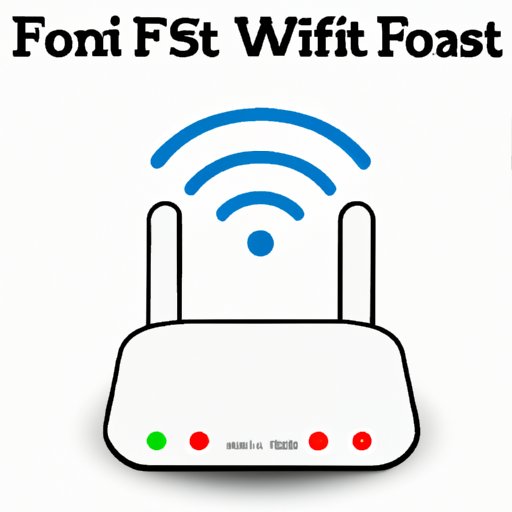Introduction
A hotspot is a location where wireless Internet access is available for anyone who has a device that can connect to it. Hotspots are usually found in public places like airports, cafes, libraries, and hotels, but they can also be found in private homes and businesses. Hotspots provide users with a convenient way to stay connected while on the go, allowing them to access the Internet wherever they are. By understanding how hotspots work, you can take advantage of the many benefits they offer.

Exploring the Technology Behind Hotspots
Before exploring how to use a hotspot, it’s important to understand the technology behind them. A hotspot is created when a wireless access point (WAP) is connected to an internet source, such as a cable or DSL modem. The WAP then broadcasts a signal that allows users to connect to the internet. It is important to note that the range of the signal will depend on the type of WAP used and other factors such as interference from other devices.
How Does a Hotspot Work?
When a user connects to a hotspot, their device will search for the WAP and detect its signal. Once the connection is established, the user’s device will receive an IP address from the WAP, which allows them to access the internet. Depending on the type of hotspot, users may be required to enter a username and password before they can access the internet.
How to Connect to a Hotspot
Connecting to a hotspot is relatively easy and only takes a few steps. First, you must make sure your device is configured to connect to a wireless network. Then, you need to locate the hotspot and check if it requires a username and password. If it does, you will need to enter this information before you can connect. Finally, you can select the hotspot from the list of available networks and connect to it.

The Benefits of Using Hotspots
Hotspots offer users a number of benefits. They allow users to stay connected while on the go, increasing their mobility. This makes it easier for people to stay in touch with friends and family, conduct business, and stay up-to-date on news and events. Hotspots also offer cost savings, since users don’t have to pay for a separate internet subscription at home or in the office. Additionally, by connecting to a hotspot instead of using their own data plan, users can save money on their mobile phone bill.
Hotspots also offer increased productivity, since users can access the internet anywhere they are. This allows them to stay connected and productive even when they’re away from their desks or out of the office. In addition, many hotspots offer reliable and fast connections, making it easier to stream videos, download large files, and upload content quickly.
Troubleshooting Common Hotspot Issues
Despite the many benefits of using hotspots, there are some potential issues that can arise. One of the most common issues is slow connection speeds, which can be caused by a variety of factors. These include signal interference from other devices, overcrowded hotspots, and poor network setup. To resolve this issue, you should try moving to another location or resetting your device.
Another issue that can arise is interference from other devices, such as Bluetooth speakers or microwaves. To reduce interference, you should move away from the device causing the interference and try connecting again. You should also make sure that the hotspot you’re connecting to isn’t overcrowded, as this can lead to slow connection speeds.
Comparing Different Types of Hotspots
There are three main types of hotspots: public hotspots, private hotspots, and mobile hotspots. Public hotspots are typically found in public places like airports, coffee shops, and libraries. These hotspots are free and open to anyone, making them ideal for casual browsing and checking emails. Private hotspots are typically found in homes and businesses, and they require a username and password to connect. Mobile hotspots are small devices that create a Wi-Fi network and allow users to connect to the internet wherever they are. These are ideal for people who travel frequently and need to stay connected.
Understanding Hotspot Security
When connecting to a hotspot, it’s important to understand the security measures in place to protect your data. Most hotspots use encryption protocols to secure the connection between your device and the hotspot. Additionally, many hotspots have firewall settings that can be adjusted to prevent malicious software from accessing your device. Finally, using a virtual private network (VPN) can help ensure that your data remains secure when accessing a public hotspot.

Exploring Hotspot Apps and Services
There are a number of apps and services available to help users find and connect to hotspots. Popular hotspot apps such as Fon and WeFi allow users to easily locate nearby hotspots and connect to them. Additionally, many mobile carriers offer hotspot services that allow users to connect to the internet on their phones. These services typically require a subscription fee, but they can be a great option for those who need to stay connected while traveling.
Conclusion
Hotspots offer users a convenient and cost-effective way to stay connected while on the go. By understanding the technology behind hotspots and the security measures in place to protect your data, you can take advantage of the many benefits they offer. Additionally, there are a number of apps and services available to help you find and connect to hotspots, allowing you to stay connected wherever you are.
(Note: Is this article not meeting your expectations? Do you have knowledge or insights to share? Unlock new opportunities and expand your reach by joining our authors team. Click Registration to join us and share your expertise with our readers.)
